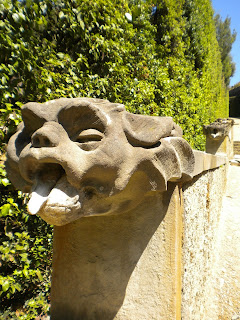Got a bit overwhelmed with other things and lost my blogging mojo this year. Oh well, it's nearly over. Bring on 2014.
But I have been missing my grotesques, and recently remembered that I hadn't blogged about the Medici grottos in the Boboli Gardens. So let's try this, for a gentle re-entry into grotesquerie...
In addition to the incredible Palazzo Vecchio, which I posted about here, the Boboli gardens were one of the highlights of my stay in Florence. Not only are the grounds utterly magnificent, but they stretch for miles and you can explore all day if you want (and have the fitness for some extreme hills).
More importantly - at least from my biased perspective - the gardens are also a haven for sculptural grotesques.
Possibly inspired by real life rather than pure imagination...
This pathway had a drain running down the side - each step punctuated by a different grotesque head vomiting water into the channel below:
But for me these were all preambles to the real novelty - the Medici grottos.
By way of a quick reminder:
The word grotesque comes from the same Latin root as "grotto", which originated from Greek krypte "hidden place," meaning a small cave or hollow.
Of course, the dark places that inspired the creation of the term grottesche were not real caves at all, but the buried rooms of the Domus Aurea (which I also visited, sort of). For this reason I find the creation of artificial grottos during this time very interesting. It promises to reveal something of how 16th century artisans imagined the origin space of grotesquerie; the kind of environment in which grotesques emerge and belong.
And honestly, I had never seen anything quite like this before (click photos to enlarge):
Some contextual info via Atlas Obscura:
[T]he Buontalenti Grotto was commissioned by Francesco I de’ Medici in order to complete the previous Vasari project, a complicated plan to create a huge nursery garden which was left unfinished.
[...] The facade is completely overlaid with concretions similar to stalagmites. The tympanum is displayed in the center and the Medici coat of arms is supported by two mosaic feminine figures symbolizing Peace and Justice. The background of the facade, on which all of this sits, is decorated by mosaic frames containing sea goats and other mythical designs.
Once inside, visitors notice that the Buontalenti Grotto is divided into three communicating rooms. The first, bigger than the other two, has walls decorated with fake stalactites and stalagmites, sponges, stones, and shells that are laid out to resemble anthropomorphic figures. Carved by Pietro Mati, these designs are meant to resemble a natural grotto - with a twist.
Here, in the main room of the Grotto, is a hole in the center of the ceiling where a fishpond was once set. (Before the restoration, the entire place was filled with waterworks, including sluices, which forces the water to create iridescent shimmers on the walls.) The hole is set in the center of ceiling frescoes that represent an arbor with wild animals and satyrs designed by Bernardino Poccetti.
The way the concrete has been applied makes everything look like it's dripping and oozing, yet frozen and hard at the same time. A very unique and uncanny effect. Especially with faces peering out from the depths.
Atlas Obscura use the term "concretions" to describe the style, which I love, because it does look like concrete is secreting from the walls. (The normal use of this term actually refers to natural formations.)
While the Buontalenti Grotto is the largest of these man-made caverns, the gardens are full of smaller grottos, many of which are decorated in the same style. Some are closed, and it was difficult to get usable photographs of their dimly lit interiors through the bars.
Some had clearly been stripped and left to serve as party spots for locals.
Others had been more carefully preserved.
As shown above, more familiar grotesque forms are also present in some of these grottos, where "concretions" form the backdrop, or even provide textured frames for paintings and frescoes.
Beautiful.
I would recommend a visit to the Medici grottos if you ever get the chance. Just make sure you wear sensible shoes. The Boboli gardens eat high heels for breakfast.













































No comments:
Post a Comment